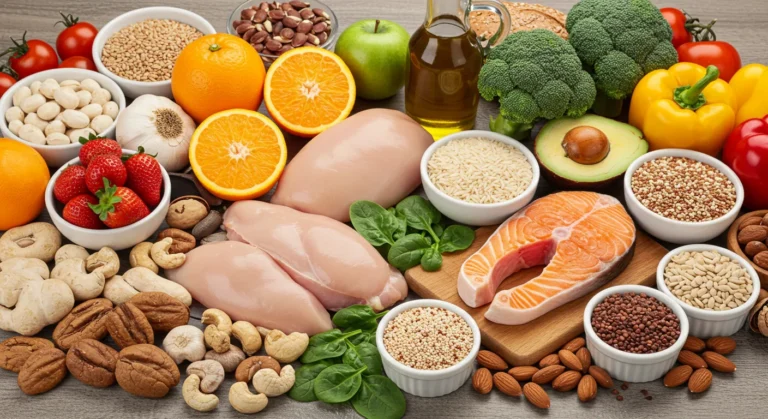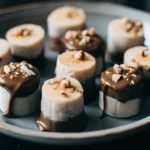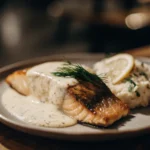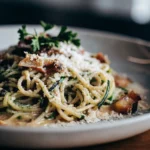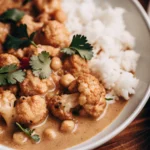Let’s be honest: trying to eat “right” can feel like decoding a secret language. One moment, carbs are the enemy. The next, it’s all about healthy fats. Meanwhile, a friend swears by keto, another is all-in on plant-based, and the Mediterranean diet keeps popping up everywhere. If you’re like me, you’ve probably found yourself standing in a grocery aisle staring at avocados, wondering if they’re your ticket to weight loss or just another calorie trap.
That’s why I set out to simplify things. This post breaks down the best foods for losing weight naturally—no meal plan, no tracking apps, no trend-chasing. Just real, whole foods that nourish your body and support lasting results.

Why “No Plan” Still Works
You don’t need a named diet to lose weight. In fact, studies show that many of the most effective weight-loss strategies don’t involve a strict regimen at all. What matters more is consistency with healthy habits and choosing foods that help you feel full, support your metabolism, and reduce inflammation.
Rather than hopping from diet to diet, learning to focus on nutrient-dense, satisfying foods can keep things simple—and sustainable. Let’s take a look at what those foods are.
High-Fiber Heroes: Stay Full, Eat Less
Fiber is one of the biggest unsung heroes in weight loss. It slows digestion, helps control blood sugar, and makes you feel satisfied longer. And the best part? It’s found in some of the most accessible foods out there.
Beans, Lentils & Chickpeas
These humble legumes are packed with fiber and plant-based protein. Just one cup of cooked lentils has about 15 grams of fiber and 18 grams of protein. That’s a combo that keeps you full and helps curb cravings later in the day.
Try it: Add black beans to tacos, lentils to soups, or chickpeas to salads for a boost that satisfies without the crash.
Berries
Strawberries, blueberries, and raspberries don’t just taste amazing—they’re high in fiber and low in calories. Their natural sweetness also makes them a great swap for sugary snacks.
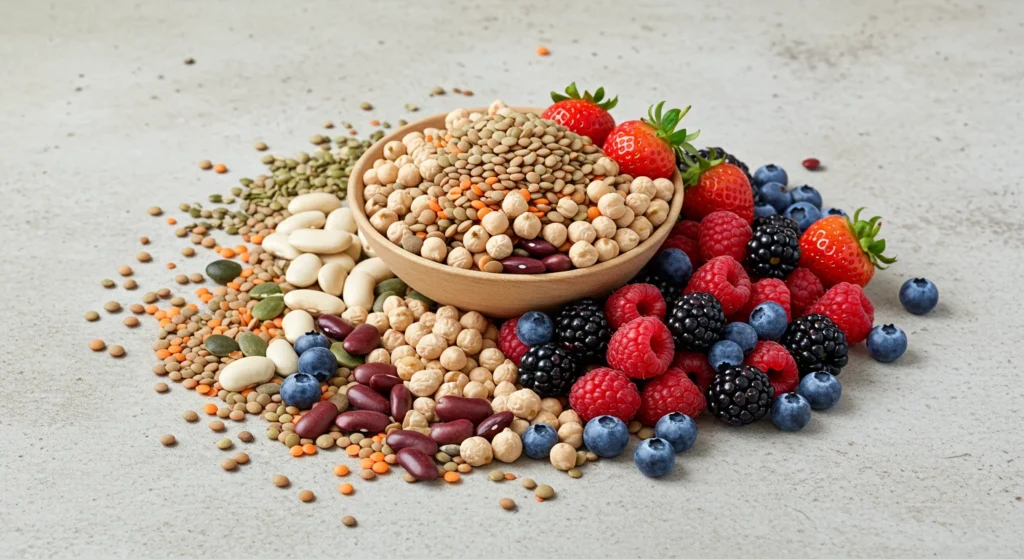
Protein Powerhouses: Keep Hunger in Check
If you’ve ever tried cutting calories and found yourself constantly hungry, it’s probably because you weren’t getting enough protein. Protein not only helps preserve muscle as you lose fat, but it also boosts your body’s calorie burn through something called the thermic effect of food.
Eggs
Eggs are affordable, easy to cook, and rich in nutrients like choline and vitamin D. One study found that people who ate eggs for breakfast felt fuller longer and ate fewer calories throughout the day.
👉 Learn more about how eggs support healthy weight in this research summary.
Quick tip: Pair eggs with leafy greens or sautéed veggies for a low-calorie, high-protein breakfast.
Greek Yogurt
Plain Greek yogurt is higher in protein and lower in sugar than traditional yogurt. Plus, the probiotics support gut health, which can play a role in metabolism and appetite regulation.
Watch out: Some flavored yogurts are loaded with added sugars, so stick with unsweetened and add your own fruit.
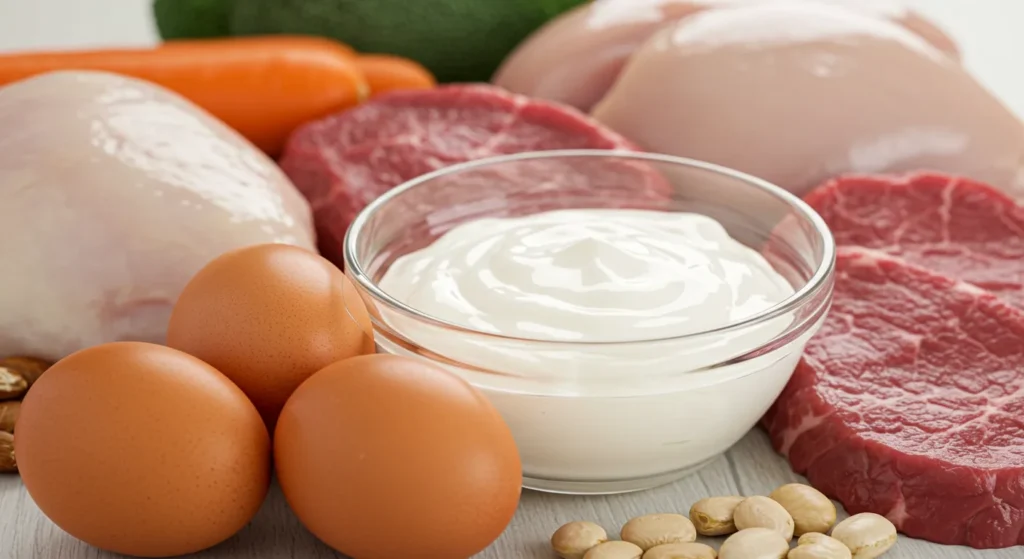
Healthy Fats: Not the Enemy
Fats have had a bad reputation, but not all fats are created equal. Certain types of fat—especially those from plants and seafood—can help you feel full, support brain health, and even reduce cravings.
Avocados
Yes, avocados are high in fat, but it’s the good kind: monounsaturated fats. They also contain fiber and potassium. Studies suggest that people who eat avocados regularly tend to have smaller waistlines and healthier diets overall.
👉 This research explains the link between avocado consumption and better weight management.
Keep it simple: Spread avocado on whole grain toast or add slices to grain bowls and salads.
Nuts & Seeds
A handful of almonds, walnuts, or pumpkin seeds makes for a satisfying snack. They’re calorie-dense, so portion control matters, but the fiber-fat-protein trio keeps you fuller longer.
| Nut/Seed | Calories (1 oz) | Protein (g) | Fiber (g) | Notable Nutrients |
|---|---|---|---|---|
| Almonds | 164 | 6 | 3.5 | Vitamin E, Magnesium |
| Pumpkin Seeds | 151 | 7 | 1.7 | Zinc, Iron |
| Walnuts | 185 | 4.3 | 1.9 | Omega-3s, Copper |
Water-Rich Foods: Volume Without the Calories
One of the simplest ways to eat fewer calories without feeling deprived? Choose foods with high water content.
Leafy Greens & Cruciferous Veggies
Spinach, kale, romaine, broccoli, and cauliflower are low in calories and high in volume. They’re great for filling your plate and your stomach—without going overboard on calories.
👉 This guide from the CDC recommends these vegetables as part of a weight-friendly eating pattern.
My go-to: Stir-fry broccoli with garlic and olive oil or toss spinach into smoothies and soups.
Watermelon, Cucumber & Celery
These are the hydrating MVPs. They’re great for snacking and help curb cravings for salty or sweet processed foods.
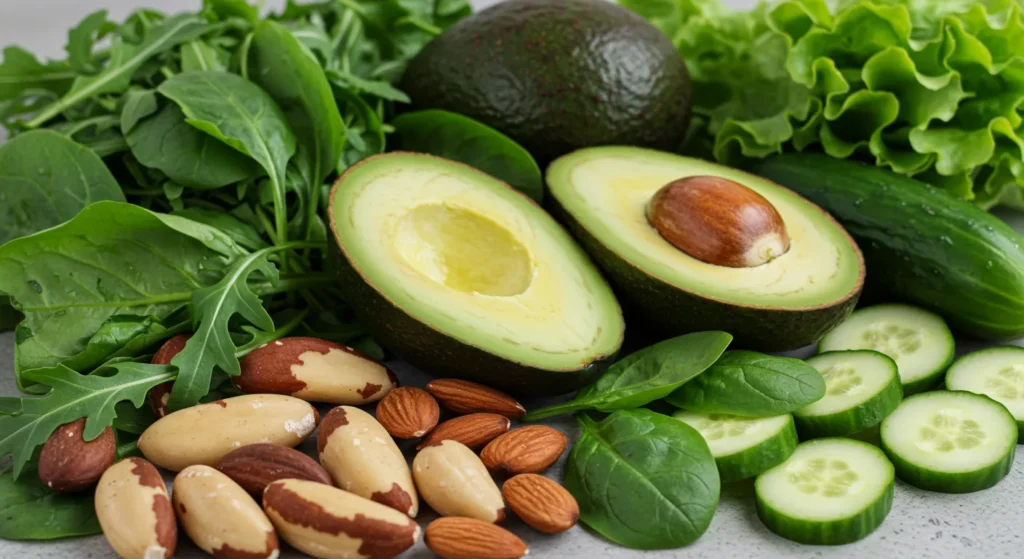
Whole Grains: Carbs That Work With You
Let me just say it: not all carbs are the enemy. The key is choosing whole grains instead of refined ones. Whole grains are digested more slowly and have more fiber, which keeps you full and supports steady energy.
Quinoa, Oats & Brown Rice
Quinoa is a complete protein, oats help reduce cholesterol, and brown rice is a great side dish for nearly any meal. All of them beat their processed counterparts hands down.
Try it: Swap white rice for quinoa or use rolled oats to make overnight oats instead of sugary cereal.
Drinks That Don’t Sabotage Your Progress
Even if you’re eating well, drinks can sneak in a ton of extra calories and sugar. Swapping sugary or creamy drinks for simple, low-calorie options can have a big impact.
Green Tea
Green tea contains antioxidants called catechins, which may support fat-burning. Plus, it’s hydrating and caffeine gives a gentle energy lift.
👉 A review shows that green tea extract is linked with weight loss in overweight adults.
Water with Citrus or Herbs
Plain water too boring? Add lemon, mint, or cucumber slices. It feels refreshing and helps you avoid high-calorie beverages without feeling deprived.
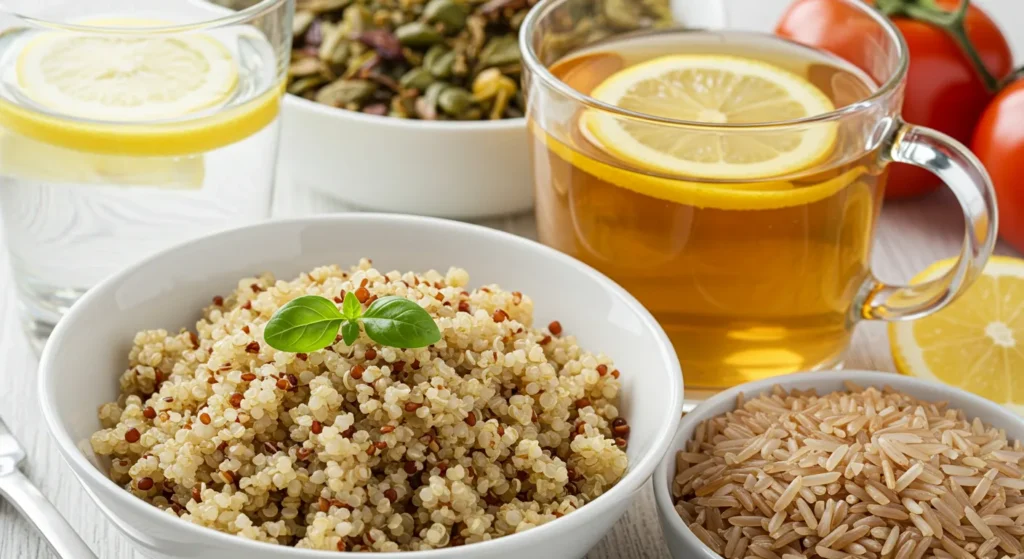
What Foods Aren’t on This List—and Why
If you’ve been comparing every “good food” list you’ve read, you might be just as confused as I was. Some say potatoes are bad; others list them as filling and high in potassium. One diet bans bananas; another encourages them as a healthy snack.
The truth? Most foods aren’t inherently good or bad. What matters is how often you eat them, what you pair them with, and how they fit into your bigger picture.
I used to avoid bananas because a blog said they had “too much sugar.” But when I started eating one with peanut butter before workouts, I noticed I had more energy and felt satisfied longer. That’s the kind of real-life balance I’ve learned to trust.
How to Make These Foods Work for You (No Plan Needed)
The key isn’t following a perfect meal plan—it’s creating simple habits that stick. Here’s how to get started:
| Habit | Why It Works |
|---|---|
| Add a vegetable to every meal | Increases volume and nutrients without many calories |
| Snack on nuts, yogurt, or fruit | Keeps blood sugar steady and prevents overeating later |
| Choose water or tea over soda | Cuts liquid calories and supports hydration |
| Build meals around protein | Helps you stay full and preserve muscle while losing fat |
| Cook more at home | Gives you control over ingredients and portion sizes |
You don’t need to obsess over macros or weigh every ounce. Just look at your plate and ask: “Is there a whole food here?” More often than not, that’s enough.
Final Thoughts: Keep It Simple, Keep It Real
If you’re feeling stuck between fad diets, conflicting advice, and food rules, you’re not alone. I’ve been there—overwhelmed by labels and convinced I was doing it “wrong.”
But the truth is, weight loss doesn’t require a perfect plan. It just needs better choices, more often. Start with a few foods from this list. Notice how they make you feel. Adjust as you go.
You don’t have to do it all. You just have to do something. One avocado. One bowl of lentils. One glass of water. That’s a good start.


